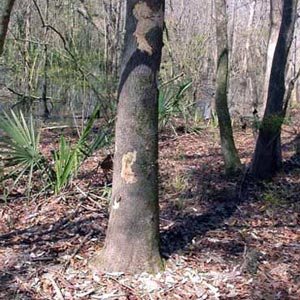Magazine | Études
Des indices de la présence du Pic à bec d’ivoire en Floride

Possible trace de nourrissage (écorce arrachée) du Pic à bec d’ivoire (Campephilus principalis) le long de la Choctawhatchee River en Floride.Source : Geoffrey Hill
Introduction
L’annonce officielle de la redécouverte du Pic à bec d’ivoire (Campephilus principalis) dans l’Arkansas en avril 2005 a constitué un événement ornithologique international. Mais les preuves avancées (une courte vidéo de qualité médiocre, des observations par des biologistes, des enregistrements) n’étaient guère concluantes. Le 21 mai 2005, Geoff Hill, professeur d’ornithologie à l’Université Auburn (Alabama), et deux assistants de recherche Tyler Hicks et Brian Rolek, faisaient un trajet en kayak le long de la Choctawhatchee River dans le « Panhandle » de Floride. Une heure après avoir mis à l’eau leurs bateaux, ils ont entendu un oiseau martelant fort sur un arbre. Quand il a survolé la canopée, Brian a vu clairement un grand pic avec du blanc au dessus et au dessous de l’arrière des ailes. Une heure plus tard, Geoff a entendu un double coup typique du Pic à bec d’ivoire. Dans ce même secteur, ils ont trouvé de grandes cavités creusées dans des troncs d’arbres et des troncs où les pics avaient retiré récemment l’écorce d’arbres morts. L’observation de Brian, le coup double, les énormes cavités et l’écorce arrachée suggéraient la présence possible d’un Pic à bec d’ivoire dans cette forêt mâture.
Geoff, Tyler, et Brian ont alors décidé d’organiser une recherche durant l’hiver 2005-2006 pour essayer de rassembler des preuves de la présence de Pics à bec d’ivoire. De mai 2005 à avril 2006, 13 contacts visuels, des dizaines de contacts auditifs, de grandes cavités dans des troncs d’arbre et de troncs à l’écorce arrachée ont été recensés.
Geoffrey Hill (Auburn University, Alabama) et Dan Mennill (University of Windsor, Ontario), deux des auteurs de l’article intitulé « Données suggérant la présence du Pic à bec ivoire (Campephilus principalis) en Floride (États-Unis) » publié en septembre 2006 dans la revue canadienne Avian Ecology and Conservation (Ecologie et Conservation des Oiseaux), nous ont permis de diffuser plusieurs photos de ces indices.
Abstract
On May 21, 2005 Dr. Geoff Hill, ornithology professor at Auburn University, and two research assistants, Tyler Hicks and Brian Rolek, took a kayak trip down the Choctawhatchee River in the Florida panhandle. Within an hour of launching their boats, they heard a bird hammering loudly on a tree. When the bird flew off through the canopy, Brian got a clear view of a large woodpecker with white on both the upper- and underside of the trailing edge of the wings. An hour later, Geoff heard a double knock, the diagnostic display raps of an Ivory-billed Woodpecker. In this same area, they found large cavity entrances on the trunks of trees and places where woodpeckers had scaled tightly adhering bark from recently dead trees. Brian’s sighting, the double knock, the huge cavity entrances, and the scaled bark all suggested that an Ivory-billed Woodpecker might exist in this mature swamp forest. One week later, Geoff and Tyler returned to the area. They split up to search the forest, and at nearly the same spot where Brian saw an ivorybill the week before Tyler got an excellent view of a female Ivory-billed Woodpecker through his binoculars as it flew through the understory and then swooped up and disappeared in the canopy of the forest. Tyler noted several diagnostic plumage characteristics of a female Ivory-billed Woodpecker including upper and underwing pattern, white stripes down the sides of the bird’s back, and an all black crest. In late July Brian returned to the area and watched two Ivory-billed Woodpeckers fly over a creek channel. The second bird followed the first bird as is described in the historic literature on ivorybills.
Geoff, Tyler, and Brian decided to conduct a winter search to try to gather better evidence for the presence of ivorybills. They asked Dr. Dan Mennill to join the search and conduct sound monitoring in the area.
Between May 2005 and April 2006, 13 probable Ivory-billed Woodpecker were seen, and dozens of feedings signs, large cavities, « kent ! » and double raps were counted, suggesting that a population of Ivory-billed Woodpeckers may have survived in the Choctawhatchee River Basin.
We propose you some photos of the search and the collected evidences.
Poursuivez la lecture de cet article, en vous abonnant dès maintenant !
Découvrez les Archives d’Ornithomedia.com
Pour seulement 10,00 €TTC/an (ou 6,00 € les 6 mois)
Profitez de plusieurs centaines d’articles en accès illimité et sans aucun engagement.
Compléments
À lire aussi sur Ornithomedia.com
- Deux possibles vidéos d’un Pic à bec d’ivoire réalisées en Louisiane
- Les critères d’identification du Pic à bec d’ivoire
Sources
- Geoffrey E. Hill, Daniel J. Mennill, Brian W. Rolek, Tyler L. Hicks et Kyle A. Swiston (2006). Données suggérant la présence du Pic à bec ivoire (Campephilus principalis) en Floride (États-Unis). Avian Conservation and Ecology 1(3): 4.
- Geoffrey Hill et Daniel Mennill. Ivory-billed Woodpecker in the Florida Panhandle. http://www.auburn.edu/academic/science_math/ivorybill/




Aucun commentaire sur ce sujet
Participer à la discussion !